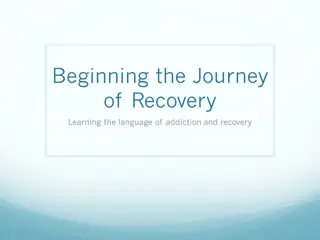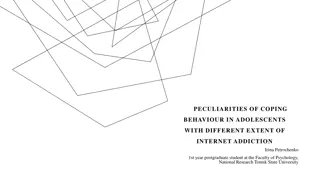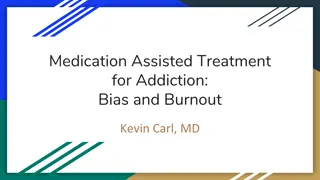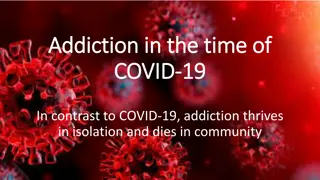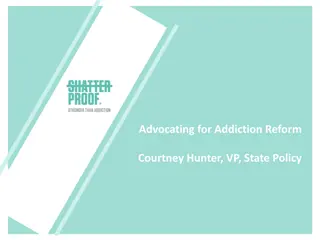Navigating Media Interviews on Hot Button Addiction Issues
Deepen your understanding of ASAM's policy positions on addiction care intersecting with controversial topics. Learn to handle media interviews effectively as an addiction specialist physician. Explore hotly debated issues like decriminalization of drug use, harm reduction, methadone expansion, and cannabis prescribing. Discover strategies to address pushback, manage defensive interviews, and engage with various media audiences, from industry trades to Capitol Hill and mainstream media outlets.
Download Presentation

Please find below an Image/Link to download the presentation.
The content on the website is provided AS IS for your information and personal use only. It may not be sold, licensed, or shared on other websites without obtaining consent from the author.If you encounter any issues during the download, it is possible that the publisher has removed the file from their server.
You are allowed to download the files provided on this website for personal or commercial use, subject to the condition that they are used lawfully. All files are the property of their respective owners.
The content on the website is provided AS IS for your information and personal use only. It may not be sold, licensed, or shared on other websites without obtaining consent from the author.
E N D
Presentation Transcript
Using Your Voice: A Guide Using Your Voice: A Guide to Talking to the Media to Talking to the Media About About Hot Hot Button Issues Button Issues July 15, 2022
Welcome! Welcome! Goals for Today s Training Deepen understanding of ASAM s policy positions on hotly debated issues intersecting with addiction care Learn how to navigate media interviews on controversial topics as an addiction specialist physician
Call Agenda Call Agenda Overview of ASAM s hotly debated addiction policy topics Examples of pushback from opposing viewpoints How to manage an interview that puts you on defense Questions and review
Media Audiences Media Audiences Trades (industry) health practice trade reporters/mags/pubs/blogs targeting colleagues, payers, other health sectors (ex. mental health) Capitol Hill (policy) Hill pubs read by Congress, Administration, think tank leaders, national associations National mainstream (react or pitching specific position on sweeping addiction treatment legislation) major daily newspapers, network news, NPR targeting broad audience including consumers State outlets (state specific ex. legislation on parity/needle exchange) state house reporters, health care reporters for state newspapers/broadcast
ASAM Hot Button Issues ASAM Hot Button Issues Decriminalization of Personal Drug Use Harm Reduction Methadone Expansion Through Prescribing Cannabis
Decriminalization of Personal Decriminalization of Personal Drug Use Possession Drug Use Possession ASAM Supports Eliminating Criminal Penalties for Personal Use Drug Possession as a Part of a Comprehensive Policy Approach to Preventing and Treating Addiction Urgent need for policy reforms that support prevention and treatment over punishment Criminalization = proportionate negative impact on people of color given incarceration rates Emphasize that other policies (e.g. insurance coverage, education, safe & affordable housing, job skills training), must correspondingly change along with decriminalization. Ex. Portugal public safety intersection with social workers/clinicians/civil penalties for no follow through and continued problematic use/behaviors; sales remain criminally punishable Funds need to be directed to a sustainable public health/safety model that points people to early intervention/treatment, when appropriate
Pushback on Decriminalization of Pushback on Decriminalization of Personal Drug Use Possession with Answers Personal Drug Use Possession with Answers Notion that Confusion over legalization and decriminalization and that the latter might bridge to the former decriminalization will make drug use more socially acceptable and increase the rate of addiction Decriminalization will increase the supply of drugs on the illegal drug market Personal use vs. manufacturing and selling Decriminalization of personal use does not mean all drug use is permitted without interventions/consequences Decriminalization can be done without legalization ASAM is only referring to personal drug use possession There is no evidence
Harm Reduction Harm Reduction ASAM supports a comprehensive approach to the overdose crisis that must includes the full continuum of evidence-informed services ranging from primary prevention and early intervention to treatment and recovery support. First save lives. Harm reduction principles focus on an individual s humanity, preferences and needs should be applied to maximize patient engagement and support their health goals. Approaches to help mitigate the negative consequences of substance use (overdose/infectious disease transmission) include naloxone access, syringe services and pilot overdose prevention sites. Glass pipes can be useful as an engagement tool that can draw an individual to lifesaving services and treatment referrals.
Pushback on Harm Reduction Pushback on Harm Reduction with Answers with Answers Opinion that those with SUD must hit rock bottom before they can be helped tough love Undermines the ability of public safety departments to stop the flow of drugs into the country Encourages and enables drug use Moral Deficit Dangerous myth; the depth of damage could make recovery more difficult or even impossible (in the event of death) SUD is a disorder and addiction is a treatable, chronic medical disease Harm reduction does not mean condoning or endorsing drug use Harm reduction does not increase US demand for drugs
Methadone Expansion Through Prescribing ASAM supports legislative & regulatory reforms that would allow pharmacy dispensing of methadone by a legally authorized prescriber of controlled medications who is: Affiliated with an OTP; or An addiction specialist physician; or A physician who has met specific qualifications The treatment of methadone for OUD has a long history of evidence-based outcomes supporting its use However, its availability is limited to certified, accredited, and heavily regulated OTPs the rigidity and locations of which are not necessarily patient-centered Addiction treatment is now recognized as a medical subspecialty; qualified prescribers outside of OTPs can safely reach more patients
Push Back on Methadone Expansion Push Back on Methadone Expansion Through Prescribing Through Prescribing with Answers with Answers Prescribers outside of OTPs are not trained to prescribe methadone for OUD Some OTP providers support only OTP clinician prescribing A lack of access to OTPs requires the expansion of trained prescribers and the ability of pharmacies to dispense for OUD Addiction specialist physicians represent some of the most educated and experienced prescribers using pharmacotherapies for OUD in the nation. As medical education continues to better integrate addiction- related curricula and training, other prescribers will emerge as qualified prescribers as well. (Ex. local pharmacies are much more common and centrally located in communities)
Cannabis Use for Medical Purposes Cannabis Use for Medical Purposes ASAM supports rescheduling cannabis used for medical purposes from Schedule 1 of the Controlled Substance Act to promote more clinical research and FDA oversight. Cannabis and cannabis-derived products should be subject to FDA review and approval to ensure their safety and effectiveness. Health care professionals should not recommend cannabis for treatment of OUD but rather FDA-approved medications (buprenorphine, methadone, & naltrexone). Currently, there are no credible studies on the efficacy of cannabis in treating OUD.
Cannabis Use for Non Cannabis Use for Non- -Medical Purposes Medical Purposes ASAM supports decriminalization of cannabis and the elimination of civil fines and fees wherever possible. A criminally legal approach to cannabis control has done significant harm particularly to people of color and not contributed to improved public health. That said, there are known risks to cannabis use, and it should be discouraged through evidence-based public health practices. States choosing to legalize cannabis use for non-medical purposes should do so using non-commercial models with substantial public health protections in place; federal policy changes can accommodate same.
Push Back Push Back on Legalization of Cannabis on Legalization of Cannabis with Answers with Answers In what Schedule should cannabis be placed? Does ASAM now support cannabis legalization? Gateway to stronger drugs ASAM supports decriminalization; ASAM opposes commercialized cannabis markets that promote use; states that choose to legalize should do so using non-commercial models with substantial public health protections in place Schedule 1 creates barriers to research; Policy experts have proposed alternatives, such as creating a new, special research sub- schedule of Schedule 1 or moving cannabis to Schedule II Research suggests cannabis use is likely to precede use of other substances and the development of addiction; however, most people who use it do not go on to use other illicit substances
General Interview Tips General Interview Tips Successful Interviews are Message Driven Rule 1: Don't have more than three main points. More than that is too confusing. Messages must be simple. Rule 2: All messages should support and bridge back to ASAM s main goals. Rule 3: Messages for the interview should align with website mission/objectives/goals Rule 4: Messages can be tailored for specific audiences, while remaining consistent
Managing an Aggressive Reporter Managing an Aggressive Reporter Stay patient and don t take the bait of a hostile question. Bridge back to your main messages for the topic. Don t repeat a negative assertion: No, I didn t say harm reduction will always lead to recovery. Move forward with a factual statement that corroborates your previous answer of if you can recall just repeat yourself! Be diplomatic about opposing views while stressing your medical training and expertise Stick with using words and phrases such as: Evidence-based . Medical science .. Credible research











